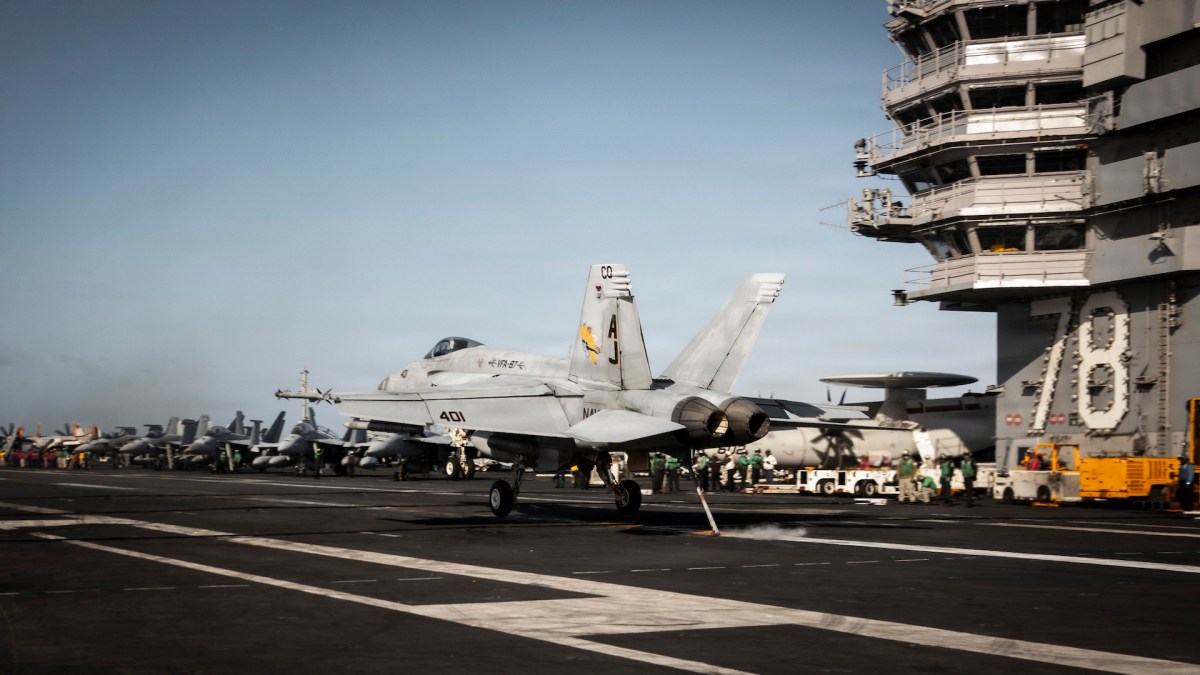US surges naval airpower to Southcom with arrival of USS Gerald R. Ford, 9 embarked squadrons

The Trump administration deployed a mix of Navy supersonic fighter jets and other advanced aircraft built for electronic warfare, command and control, contested logistics and various operations, as part of the United States’ unusually large military surge to the Caribbean this week.
America’s newest and biggest aircraft carrier — the USS Gerald R. Ford (CVN 78) — and its strike group entered the U.S. Southern Command area of responsibility on Tuesday, according to a Navy announcement.
This deployment follows a feud between President Donald Trump and Venezuelan President Nicolas Maduro that continues to intensify. The U.S. has conducted multiple deadly strikes in the region since early September against boats the second Trump administration alleges were trafficking drugs from Venezuela. Maduro and his government have repeatedly rejected those accusations, while experts have noted that the nation is not America’s top illegal narcotics supplier.
“The maritime forces’ arrival comes after Secretary of War Pete Hegseth directed the Carrier Strike Group to support the President’s directive to dismantle Transnational Criminal Organizations and counter narco-terrorism in defense of the Homeland,” officials wrote in the Navy’s press release.
Officially changing the name of the Department of Defense requires an act of Congress, but Trump recently signed an executive order rebranding DOD as the Department of War.
The Ford has nine embarked squadrons from Carrier Air Wing 8, according to the Navy, including strike fighter squadrons VFA 31, VFA 37, VFA 87 and VFA 213, Electronic Attack Squadron 142, Airborne Command and Control Squadron 124, Helicopter Sea Combat Squadron (HSC) 9, Helicopter Maritime Strike Squadron (HSM) 70, and a detachment from Fleet Logistics Support Squadron (VRC) 40.
The ship has “dozens of tactical aircraft” aboard, according to the Navy. VFA 31, VFA 37 and VFA 87 are flying the F/A-18E Super Hornet, while VFA 213 is operating the F/A-18F variant. The E/A-18G Growler is flown by Electronic Attack Squadron 142 and the E-2D Advanced Hawkeye is operated by Airborne Command and Control Squadron 124.
Such capabilities and their open mission systems architecture are designed for integration of new technologies.
Helicopter Sea Combat Squadron (HSC) 9 is operating the MH-60S Seahawk, Helicopter Maritime Strike Squadron (HSM) 70 is flying the MH-60R, and the detachment from Fleet Logistics Support Squadron (VRC) 40 is using the Carrier Onboard Delivery C-2A Greyhound.
More than 4,000 sailors are also aboard the Ford, which can simultaneously catapult launch and recover fixed-wing aircraft on its flight deck.
Anti-air, anti-submarine and anti-surface capabilities are additionally provided by the destroyers in the carrier strike group, which include USS Bainbridge (DDG 96), USS Mahan (DDG 72), and USS Winston S. Churchill (DDG 81).
The Navy press release did not disclose whether any submarines are accompanying the Ford.
These major military assets will augment joint forces already in Southcom’s area of responsibility. Pentagon leaders previously sent eight warships, F-35 fighter jets and at least one nuclear-powered submarine to the region.
“The USS Gerald R. Ford Carrier Strike Group’s deployment represents a critical step in reinforcing our resolve to protect the security of the Western Hemisphere and the safety of the American homeland,” Southcom Commander Adm. Alvin Holsey said.
In October as the Pentagon was escalating its assault on alleged narco-smugglers, Holsey confirmed that he plans to leave his post less than one year into his tenure leading the command. He hasn’t publicly shared the motivation behind his seemingly premature retirement.
“Through unwavering commitment and the precise use of our forces, we stand ready to combat the transnational threats that seek to destabilize our region,” Holsey noted in Tuesday’s press release.
Dozens of people have been killed in the U.S. military’s strikes in the Caribbean during the second Trump administration, so far.
Since Hegseth initiated the first strikes, analysts have interrogated the legality of these missions under American and international law. Some experts have also questioned the need for this mass buildup of such powerful weapons systems to counter the less-equipped boaters DOD is said to be targeting, and if the Trump administration is using the deployment as an intimidation tactic.
Members of Congress have also raised concerns about the administration’s lack of transparency or provided proof about who and what the strikes have taken out to date.
On Tuesday, reports emerged that the United Kingdom was suspending intelligence-sharing with the U.S. for its operations against suspected criminal vessels in the Caribbean. When asked to confirm or deny this move, a U.K. government spokesperson told DefenseScoop: “It is our longstanding policy to not comment on intelligence matters. The U.S. is our closest ally on security and intelligence. We continue to work together to uphold global peace and security, defend freedom of navigation, and respond to emerging threats.”
Separately, several nations have reportedly denounced America’s operations in Southcom.
The Venezuelan Ministry of Defense started mobilizing the country’s military forces on Tuesday for a large-scale exercise, in response to the growing U.S. presence.




